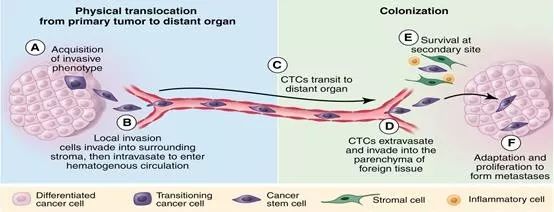Background
Circulating tumor cell (CTC) is a kind of tumor cell which is shed from the primary site and invades the blood circulation. CTC can evade immunity defense and stay in the primary or distant organs, thus forming recurrence and metastasis.When the number of tumor cells increases gradually, the matrix metalloproteinases secreted by them also increase gradually, and they will break through the basement membrane barrier and enter the blood through the gradual digestion of type IV collagen protein, which is called CTC; when CTC enters the blood, it will follow The distant metastasis of different tumors is closely related to the distribution of blood flow. For example, breast cancer usually has secondary lesions in the lung, while colon cancer often forms liver metastasis.
Circulating tumor cells are one of the few new tumor molecular markers that have been studied and applied in recent 30 years. By detecting the quantity and protein expression of CTC, we can diagnose the tumor, judge the prognosis and monitor the curative effect. For example, when there is epithelial mesenchymal transition (EMT) and overexpression of epithelial cell adhesion molecules in CTC, the prognosis of cancer patients is often poor; by comparing the amount of CTC in blood before and after surgery or radiotherapy and chemotherapy, we can judge whether the treatment is effective, which has important clinical research and Application value.

Circulating tumor cells are one of the few new tumor molecular markers that have been studied and applied in recent 30 years. By detecting the quantity and protein expression of CTC, we can diagnose the tumor, judge the prognosis and monitor the curative effect. For example, when there is epithelial mesenchymal transition (EMT) and overexpression of epithelial cell adhesion molecules in CTC, the prognosis of cancer patients is often poor; by comparing the amount of CTC in blood before and after surgery or radiotherapy and chemotherapy, we can judge whether the treatment is effective, which has important clinical research and Application value.
Reference:
[1] Inhestern J, Oertel K, Stemmann V, et al. Prognostic Role of CirculatingTumor Cells during Induction Chemotherapy Followed by Curative Surgery Combinedwith Postoperative Radiotherapy in Patients with Locally Advanced Oral andOropharyngeal Squamous Cell Cancer[J]. Plos One, 2015, 10(7).
[2] Li T T, Liu H, Li F P, et al. Evaluation ofepithelial-mesenchymal transitioned circulating tumor cells in patients withresectable gastric cancer: Relevance to therapy response[J]. World Journal of Gastroenterology, 2015, 21(47):13259.
[3] Nieva J, Wendel M, Luttgen M S, et al.High-definition imaging of circulating tumor cells and associated cellularevents in non-small cell lung cancer patients: a longitudinal analysis.[J].Physical Biology, 2012, 9(1).
[4] Liu Y, Ling Y, Qi Q, et al. Prognostic valueof circulating tumor cells in advanced gastric cancer patients receivingchemotherapy.[J]. Molecular & Clinical Oncology, 2017, 6(2):235.
